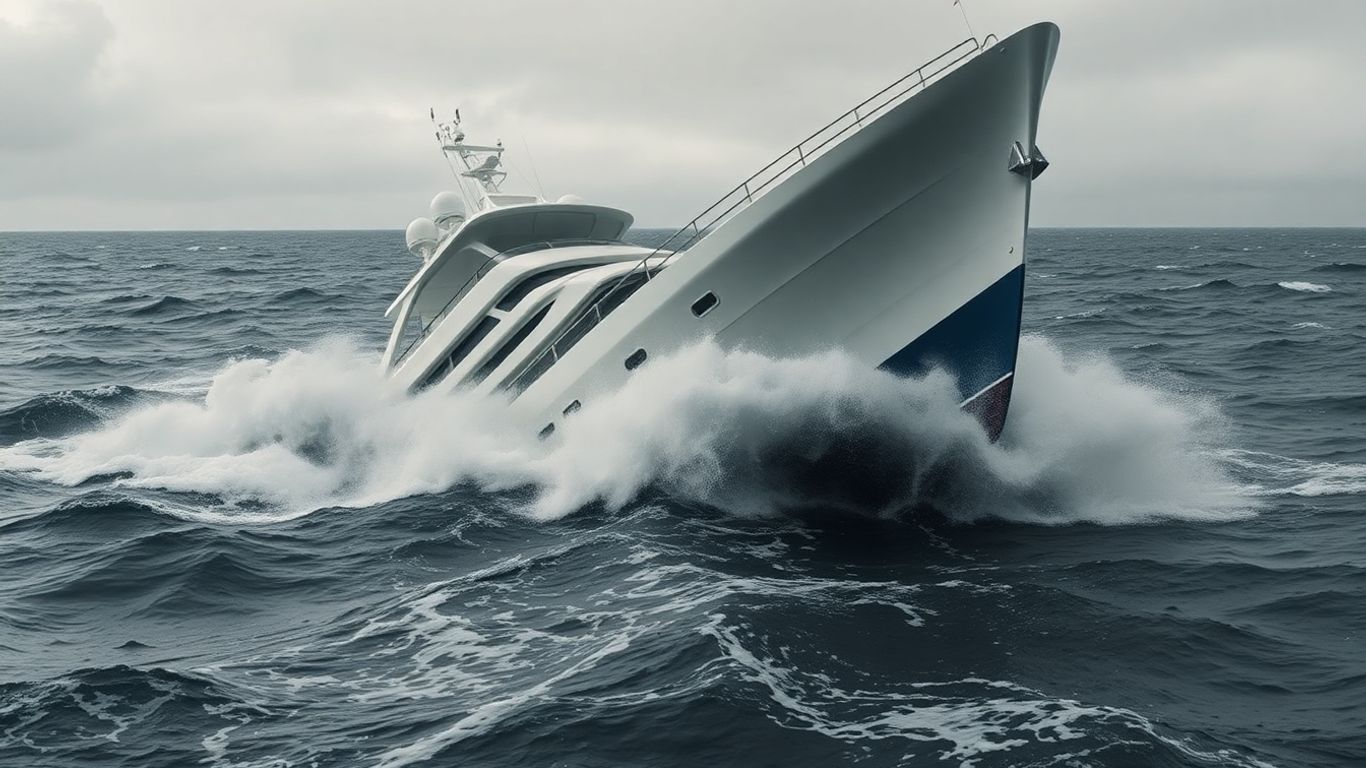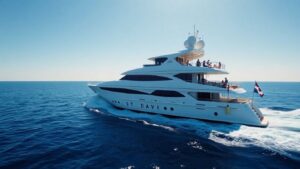It seems like every so often, we hear about another yacht that’s flipped over or sunk. It’s a bit unsettling, especially when you think about how much money and effort goes into these beautiful vessels. We wanted to look into why this keeps happening and what can be done about it. Are certain conditions more dangerous? Is it about the age of the boat, or maybe the people on board? Let’s break down the factors that contribute to yachts capsizing and what steps can be taken to prevent these incidents.
Key Takeaways
- Environmental factors like strong winds and rough seas significantly increase the risk of yachts capsizing.
- Older yachts, especially those over 30 years old or with poor maintenance records, are more vulnerable to accidents.
- The experience and training of the crew play a massive role; less experienced crews or those with invalid certificates are more likely to be involved in serious incidents.
- Specific accident types, such as capsizing/sinking, are strongly linked to very serious outcomes for yachts.
- Regular inspections of the hull and machinery, along with strict adherence to safety rules and proper crew training, are vital for preventing yachts capsizing.
Understanding the Factors Contributing to Yachts Capsizing
[{"h2": "Understanding the Factors Contributing to Yachts Capsizing", "content": "It seems like every so often, we hear about another yacht that’s run into trouble, sometimes with really bad outcomes. It’s not just random bad luck, though. There are definitely things that make these boats more likely to get into trouble. We need to look at what’s going on with the weather, how old the boat is and if it’s been looked after, and, of course, how much experience the people on board actually have. These all play a big part in whether a yacht stays upright and safe or ends up in a bad situation.", "h3s": [{"h3": "Influence of Environmental Conditions on Vessel Stability", "content": "The sea can be a pretty wild place, and the conditions out there really matter for a yacht’s stability. Think about it: strong winds can push a boat around, and big waves can rock it pretty hard. If a yacht isn’t designed or handled right for these conditions, it can get into trouble fast. We’ve seen that accidents tend to be worse when the seas are rough and the wind is blowing hard. It’s like the ocean is testing the boat and the crew, and sometimes, the boat doesn’t pass the test."}, {"h3": "Impact of Ship Age and Maintenance on Structural Integrity", "content": "Just like any machine, yachts get older, and their parts can wear out. If a yacht isn’t kept up with regular checks and repairs, its structure might not be as strong as it should be. This is especially true for older boats. Things like rust, weakened materials, or outdated safety equipment can all add up to make a boat more vulnerable. A yacht that’s over 30 years old, especially if it hasn’t had proper upkeep, is more likely to be involved in serious incidents. It’s not just about looking good; it’s about making sure the boat is sound from the inside out."}, {"h3": "Crew Experience and Training in Navigational Safety", "content": "The people on board are just as important as the boat itself. If the crew doesn’t know what they’re doing, or if they’re tired, things can go wrong quickly. We’re talking about everything from knowing how to steer the boat in bad weather to understanding the safety equipment. Accidents are more likely to have bad results when the crew’s knowledge is shaky or they haven’t had enough time on the water. It’s a bit like driving a car; you need to know how to handle it, especially when things get tricky on the road.", "list": ["Lack of proper training can lead to poor decision-making.", "Fatigue among crew members can impair judgment and reaction times.", "Insufficient understanding of the yacht’s systems can prevent effective responses to emergencies."]}]}]}”}],
Analysis of Accident Severity and Contributing Elements
When a yacht ends up capsizing, it’s rarely down to just one thing. We’re looking at a mix of factors that can turn a pleasant day on the water into a serious incident. Understanding these elements is key to figuring out why some accidents are much worse than others.
Correlation Between Sinking Incidents and Severity
It’s pretty straightforward: when a yacht sinks, the consequences are almost always more severe. Sinking means the vessel is lost, and often, so are the people on board. This is a stark indicator of how bad things can get.
The Role of Strong Winds and Heavy Seas
Nature plays a big part, of course. Rough weather, like strong winds and big waves, puts immense stress on any vessel. For yachts, especially smaller ones or those not built for heavy conditions, this can be a major problem.
- Wind Speed: Higher wind speeds increase the force pushing against the yacht’s structure and sails.
- Wave Height: Large waves can lift the yacht and then slam it down, or even roll it over.
- Wave Direction: Waves hitting the beam (side) of the yacht are more likely to cause rolling than those hitting the bow or stern.
The combination of strong winds and heavy seas creates a challenging environment where even well-maintained yachts can be pushed beyond their stability limits.
Vessel Age and Certificate Validity as Risk Factors
An older yacht, particularly one that hasn’t been kept up with regular maintenance, can be more susceptible to problems. Similarly, if the safety certificates for the yacht or its crew are out of date or invalid, it signals a potential lapse in proper upkeep and training, which directly impacts safety.
| Factor | Impact on Severity | Notes |
|---|---|---|
| Vessel Age (>30 years) | Increased | Potential for structural wear and tear |
| Invalid Ship Certificates | Increased | Suggests lack of recent safety checks |
| Inadequate Manning | Increased | Insufficient crew for safe operation |
| Invalid Crew Certificates | Increased | Crew may lack necessary training/qualifications |
Specific Vulnerabilities of Yachts in Maritime Incidents

[{"h2":"Specific Vulnerabilities of Yachts in Maritime Incidents","h3s":[{"h3":"Yachts as Ship Types Prone to Higher Severity Accidents","content":"It’s a tough reality, but when you look at the numbers, yachts, along with fishing vessels and sailing craft, tend to show up more often in accidents that have really serious outcomes. This isn’t about pointing fingers, but more about understanding the risks. Unlike large commercial ships that have a lot of built-in stability and safety systems, yachts can be more sensitive to changes in weather and sea conditions. Their design, often focused on speed or comfort, might not always prioritize extreme stability in rough seas. This makes them more susceptible to the kind of incidents that can lead to significant damage or loss."},{"h3":"The Significance of Inadequate Manning and Certificates","content":"When a yacht is out on the water, the people on board are the first line of defense against trouble. If the crew isn’t properly trained or if their certifications aren’t up to par, it really ups the ante for potential problems. Think about it: a well-staffed and certified crew knows how to handle unexpected situations, from equipment failures to sudden weather shifts. Without that, even a minor issue can quickly spiral. It’s not just about having enough people; it’s about having the right people with the right qualifications and experience to manage the vessel safely.
Here’s a quick look at how crew issues can play a role:
- Insufficient Crew Numbers: Not enough hands on deck can lead to tasks being rushed or missed entirely.
- Lack of Proper Certification: Crew members might not have the necessary training for the type of vessel or the waters they are in.
- Expired or Invalid Certificates: Even if trained, outdated credentials can mean a lack of knowledge about current safety standards and practices.
- Inadequate Manning Levels: The number of crew might meet minimums but not be sufficient for safe operation under all conditions.
It’s a bit like trying to build a house with only half the necessary tools and half the skilled workers – things are bound to go wrong."},{"h3":"Consequences of Poor Seafarer Knowledge and Experience","content":"You can have all the fancy equipment and the best-maintained boat in the world, but if the people steering it don’t really know what they’re doing, you’re still in a risky spot. Seafarers with limited practical experience or a weak grasp of the fundamentals of seamanship are more likely to make mistakes. These aren’t just small errors; they can be the kind of mistakes that lead to major accidents. For instance, not understanding how to properly trim sails in changing winds, misjudging wave patterns, or not knowing how to react to a sudden squall can all put a yacht in serious danger. It really comes down to having that hands-on knowledge that you can only get from spending time on the water and learning from experienced mariners.
Consider these points:
- Misinterpretation of Weather: Failing to accurately read weather forecasts or understand the implications of changing conditions.
- Improper Handling of the Vessel: Incorrect steering or sail adjustments that can lead to instability.
- Inability to Respond to Emergencies: Not knowing the correct procedures for dealing with onboard issues or distress situations.
- Poor Decision-Making: Making choices that increase risk due to a lack of foresight or understanding of maritime principles.
Ultimately, the human element is often the most critical factor in preventing accidents. A well-trained and experienced crew acts as the vessel’s primary safety system, capable of anticipating and mitigating potential hazards before they escalate into full-blown incidents.
Key Indicators of Increased Risk for Yachts Capsizing
When we talk about yachts getting into trouble, like capsizing, there are definitely some warning signs that pop up more often than others. It’s not just random bad luck; certain conditions and factors really seem to make things riskier. Understanding these can help us figure out where the real dangers lie.
Accident Types Leading to Very Serious Outcomes
Not all accidents are created equal, and some types of incidents are just more likely to end badly for yachts. Sinking accidents, for instance, are a big red flag. When a yacht goes down, it’s usually a total loss, and the chances of serious injury or worse for everyone on board go way up. It’s the kind of event that spells disaster.
The Impact of Gross Tonnage and Engine Power
It might seem counterintuitive, but the size and power of a yacht can play a role in how severe an accident becomes. While larger yachts might seem more stable, their sheer mass can make them harder to manage in rough conditions. Similarly, a lot of engine power, if not handled correctly, can lead to loss of control. It’s a bit of a balancing act.
Location as a Critical Factor in Accident Severity
Where a yacht is when something goes wrong matters a lot. Being far from shore or any help when an accident happens significantly increases the severity of the outcome. If you’re in deep water with no immediate rescue options, even a minor issue can quickly become a major crisis. The distance to safety is a huge part of the risk equation.
Preventative Measures to Mitigate Yachts Capsizing Risks
So, what can we actually do to stop these yachts from flipping over? It’s not just about hoping for good weather, you know. There are some solid steps that can make a big difference.
Enhancing Crew Competency and Operational Procedures
This is a big one. Having a crew that knows their stuff is super important. It’s not enough to just have a license; you need real skill and experience, especially when things get rough. Think about it: if you’re caught in a storm, you need people who can react quickly and correctly. This means proper training, not just for the captain, but for everyone on board. Regular drills, like what to do if the boat starts listing badly or how to manage emergency equipment, are key. Plus, having clear procedures for everything, from docking to heavy weather sailing, means less guesswork when stress levels are high.
- Regular safety drills: Practice emergency responses like man overboard, fire, and capsizing scenarios.
- Continuous training: Keep skills sharp with courses on advanced seamanship, weather forecasting, and first aid.
- Clear watch schedules: Avoid fatigue by managing crew rest periods effectively. Long hours can really mess with judgment.
Crew fatigue is a serious issue that often gets overlooked. When people are exhausted, their decision-making abilities suffer, and that’s when mistakes happen. Making sure everyone gets enough rest is just as vital as having the right safety gear.
Importance of Regular Hull and Machinery Inspections
You wouldn’t drive a car without checking the tires or brakes, right? Same idea with a yacht. The hull needs to be sound, and the engines need to be running right. Small problems, like a bit of rust or a leaky seal, can turn into big disasters if they’re ignored. It’s about catching issues early before they compromise the boat’s stability or ability to maneuver.
- Hull integrity checks: Look for any signs of damage, corrosion, or stress fractures, especially around the keel and rudder.
- Engine and systems maintenance: Keep propulsion, steering, and electrical systems in top working order.
- Safety equipment servicing: Ensure life rafts, life jackets, flares, and communication devices are current and functional.
Adherence to Safety Management Systems and Regulations
There are rules for a reason. Following established safety management systems, like the International Safety Management (ISM) Code, provides a framework for safe operations. This includes everything from risk assessments to emergency preparedness. It’s about having a structured approach to safety, rather than just winging it. Staying up-to-date with regulations and making sure the yacht’s certificates are valid is also non-negotiable. Ignoring these can lead to serious consequences, including fines and, more importantly, increased risk of accidents.
- Documented procedures: Maintain clear records of maintenance, training, and operational protocols.
- Risk assessment: Regularly identify and evaluate potential hazards specific to the yacht’s operation and environment.
- Compliance checks: Ensure all safety equipment and vessel certifications meet or exceed regulatory requirements.
The Broader Context of Maritime Safety and Yacht Incidents

When we talk about yachts capsizing, it’s easy to get caught up in the specifics of individual boats or particular weather events. But it’s really important to zoom out and look at the bigger picture of maritime safety. Accidents at sea, whether it’s a massive cargo ship or a small pleasure yacht, are part of a larger system, and understanding that system helps us figure out how to make things safer for everyone. It’s not just about yachts, you know; it’s about all vessels and the people who operate them.
Trends in Marine Casualties and Incident Reporting
Looking at the numbers can be a bit sobering. We’re talking about thousands of marine casualties and incidents happening every year across the globe. The European Marine Casualty Information Platform (EMCIP), for instance, recorded an average of over 3,200 incidents annually between 2014 and 2018. And that’s just one database; many more go unreported. These aren’t just minor bumps either. They lead to significant losses of property, injuries, and sadly, even fatalities. Plus, there’s the environmental impact, which is a whole other can of worms.
- Over 3,200 average annual incidents reported in EMCIP (2014-2018).
- Significant property damage and loss of life are common outcomes.
- Environmental pollution is a serious consequence often overlooked.
Lessons Learned from Global Maritime Accident Data
Researchers have been digging into accident reports for years, trying to find patterns. They look at everything: the type of ship, how old it is, the experience of the crew, the weather conditions, and where the accident happened. What they’ve found is that certain factors just keep popping up in serious accidents. For example, older vessels, those with crews who aren’t fully qualified or experienced, and situations involving really rough seas or strong winds seem to be linked to more severe outcomes. It’s clear that a combination of factors, rather than a single cause, often leads to disaster.
The data suggests that vessels over 30 years old, along with inadequate crewing and incomplete certification, are consistently associated with higher accident severity. This points to a need for stricter oversight on vessel maintenance and crew qualifications across the board.
The Need for Systematic Studies in Maritime Safety
While a lot of research has been done, much of it focuses on specific types of ships or particular regions. We need more studies that take a broad look at maritime safety, including yachts. By analyzing accident data from all over the world and across different vessel types, we can get a clearer picture of the risks. This kind of systematic approach helps identify common weaknesses and allows authorities to create better safety rules and guidelines that actually make a difference. It’s about building a safer future for everyone on the water.
Wrapping Up: What We've Learned About Capsizing Yachts
So, after digging into why these yachts are flipping over, it’s clear there’s no single easy answer. We’ve seen how things like the age and condition of the boat, the weather, and even the experience of the people on board all play a part. It’s not just about having a fancy boat; it’s about making sure it’s well-maintained and that the crew knows what they’re doing, especially when the seas get rough. Remember, even the most luxurious vessel is still a boat, and nature can be powerful. Paying attention to these details, from regular checks to proper training, can make a huge difference in keeping everyone safe out on the water. Hopefully, this look into the problem gives owners and operators a better idea of what to watch out for.
Frequently Asked Questions
Why are yachts capsizing more often now?
Several things can cause yachts to tip over. Bad weather, like strong winds and big waves, plays a big part. Also, older yachts that haven’t been kept up well might not be as strong. Sometimes, the people on board might not have enough experience or training to handle tricky situations.
What makes a yacht accident really bad?
Accidents that cause a yacht to sink are usually the most serious. When this happens, it often means people could be lost or badly hurt. These severe accidents are more likely to happen when the weather is rough, like during storms, or if the yacht itself is old and not in great shape.
Are yachts more at risk than other boats?
Yes, studies show that yachts, along with fishing boats and sailboats, are more likely to be involved in accidents that have serious outcomes. This can be because they might have smaller crews who aren’t as experienced, or their safety equipment and training might not be as good as larger commercial ships.
What are the biggest warning signs that a yacht might be in danger?
The most dangerous situations often involve accidents that lead to a total loss of the vessel. Things like the yacht’s size (smaller ones can be more vulnerable), the power of its engines, and where it is located can all be important clues. Being in the wrong place during bad weather is a major risk.
How can we stop yachts from capsizing?
To keep yachts safer, it’s important to make sure the crew knows what they’re doing and follows safety rules. Regularly checking the yacht’s hull and engine is crucial. Following safety plans and rules set by authorities also helps prevent accidents.
What can we learn from past yacht accidents?
Looking at information from accidents all over the world helps us understand what goes wrong. By studying these events, we can see patterns, like how weather or the age of a boat affects safety. This helps experts create better rules and training to make sailing safer for everyone.



